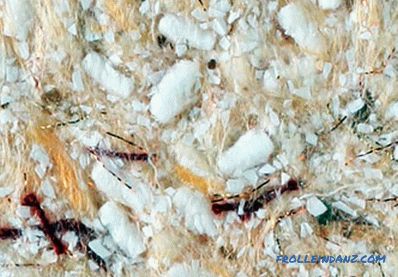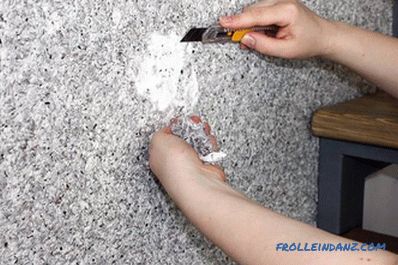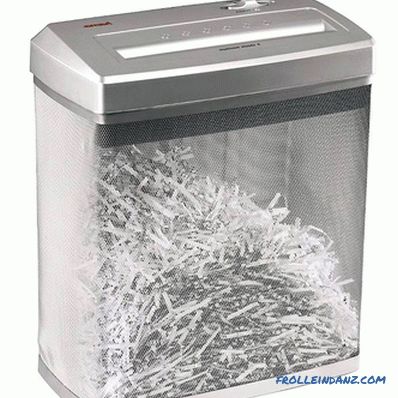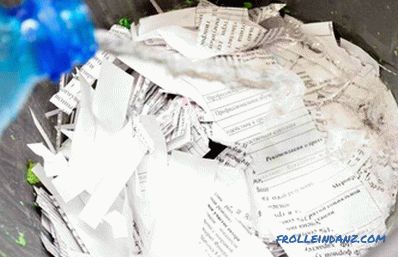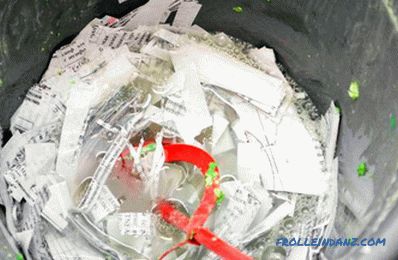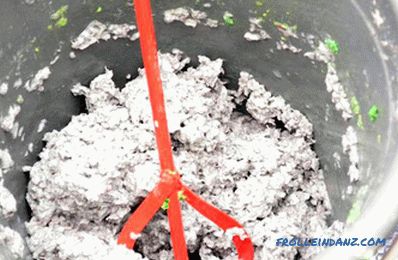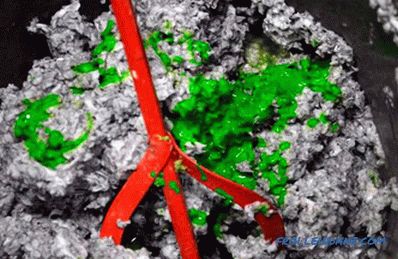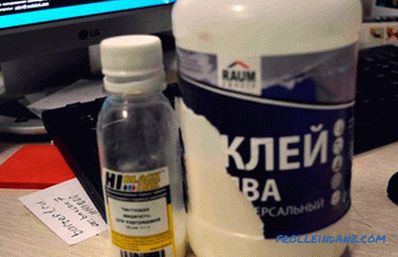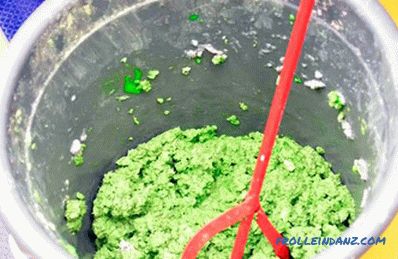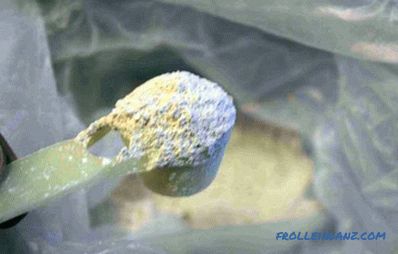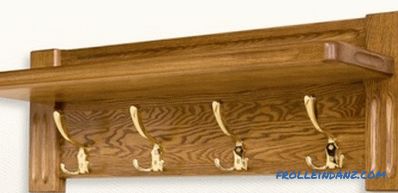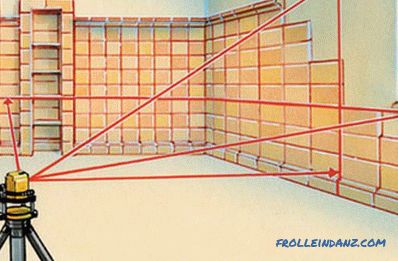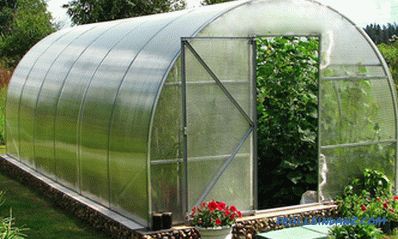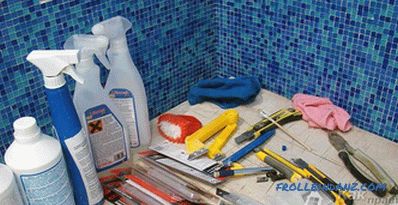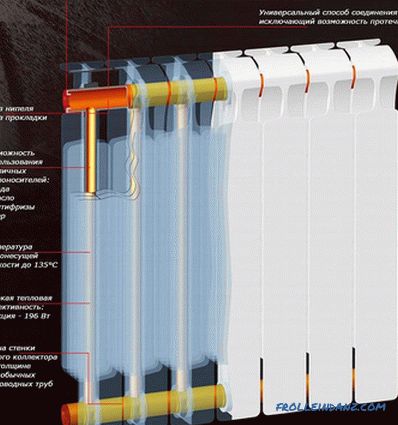When creating a unique interior, special attention is paid to the finishing of the walls, because it is them who look first of all. In pursuit of beauty and comfort, many resort to original methods of their finishing. Liquid wallpaper is very popular among craftsmen today. They are applied to the surface with brushes, rollers, spatulas and other similar tools.
Although today the ready-made mixture is easy to buy in the appropriate store, they can also be prepared at home. This is not to say that this is a simple solution, however, for those who like to do everything on their own, the technologies described in this article will be appreciated. Therefore, before making a liquid wallpaper, we recommend that you familiarize yourself with the material presented, as well as view the attached videos.
Basic properties
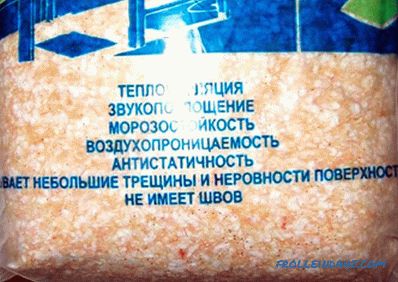 Liquid wallpapers are natural and do not harm people
Liquid wallpapers are natural and do not harm people
Main , for which liquid wallpaper - environmental friendliness. For their manufacture are selected natural materials that do not harm the environment and the human body. There are a number of positive aspects and features of this finishing material:
| Properties | Description |
| Fire safety | They are so safe that they are recommended to be used when finishing evacuation routes. According to the tests, their low ability to maintain the flame, smoke formation, a slight degree of flammability and flammability was noted. |
| Aesthetics | Using various additives, you can give the room a special appearance. At the same time it is possible to create completely different styles of interior. |
| Easy to use | To work with this material you will need a simple set of building tools. No need for special qualifications and skills. With a strong desire, you can independently understand the technology of their manufacture and application. Plus, the wall doesn't have to be perfectly smooth. Some rubbing, small potholes and other irregularities are allowed. An important requirement is a base coat primer. |
| Dryness | If you don’t allow drafts when sticking ordinary sheet wallpaper in a room, it’s the opposite with liquid. The drying process is significantly accelerated if constant air exchange is maintained in the room. Given this, the presence of a draft is even recommended. |
| Anti-static | Liquid wallpaper does not require special care during operation. There is no need to clean them regularly for the reason that they do not attract dust and other contaminants. |
| No seams | Even if the surface of the wall is curved or just straight, when applying the liquid wallpaper no joints are formed. |
| Thermal insulation | Decorative trim is an additional thermal insulation layer. With all this, the walls let in air, which has a positive effect on the general microclimate inside the room. |
| Sound insulation | The textile fibers in the liquid wallpaper create an additional barrier to sound penetration. |
| UV resistance | If the coating is exposed to sunlight for a long time, it will not change its color and specifications. |
| Frost resistance | With the observance of technology, wallpaper can be applied in poorly heated rooms and in conditions of sudden changes in temperature . |
| Ability to repair | One of the important advantages is maintainability. They can be re-applied to the defect. After repair, it will be impossible to determine the area where the restoration was performed. Given this, some experts recommend buying wallpaper with a small margin in case of repair. Accordingly, there will be no problems with the selection of colors and shades. |
Based on all the positive aspects and features, such a decoration will last more than one year.
Making liquid wallpaper at home: instructions
As already mentioned, you can make your own liquid wallpaper. In this case, you can save money. For example, the cost of one package of dry mix varies from 400 to 2 thousand rubles. On average, one package is designed for 3-7 m 2 . Based on this, you can approximately calculate how much material will be required for wall decoration in your case.
Let's carry out approximate calculations: the area of one room by floor is 15 m 2 , the height is 2.7 m.With such parameters, the area of all walls will be about 40 m 2 . If you buy a liquid wallpaper with an average price of 1100 r, then we get this calculation - 40 (total area of the room) ÷ 5 (weight in the dry state in one package) = 6 (the required number of packages). The result is multiplied by 1100 p. and we get 8800 p. With all of this should be purchased with a small margin.
Not everyone can buy even the cheapest wallpaper. Therefore, for the majority, it would be an excellent decision to make them yourself. Next, we look at options and recipes for making from:
- paper;
- sawdust.
Recipe for making liquid wallpaper from paper
First of all, you need to collect all kinds of paper residues. Although absolutely any residues will do, it is better to give preference to higher quality raw materials. You can also use crumpled paper. Water will be required, its temperature should be above room temperature. Be sure to choose a dye and gypsum. So that the liquid wallpaper was easy to apply on the walls, you can not do without a special adhesive composition. Most use PVA glue. To prepare the base, a primer must be applied, preferably with deep penetration.
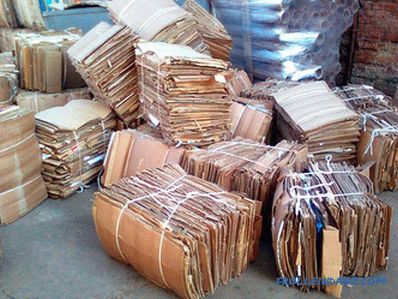 A source of raw materials can be newspapers or cardboard packaging from waste paper
A source of raw materials can be newspapers or cardboard packaging from waste paper
Besides, everything else needs such a tool :
- drill or screwdriver;
- nozzle-mixer for mixing all the ingredients;
- container of metal or plastic. Capacity size does not matter;
- spatula for applying;
- wall primer brush.
Consider the manufacturing process on the example of a small portion. Based on the needs, the proportions can be increased proportionally:
| Work steps | A detailed description of each step for making liquid wallpaper |
| Step # 1 | Take 200 grams of paper, and pre-crush it. To do this, you can use regular office scissors. |
| Step number 2 | Cut paper to be mixed with water. 200 grams of paper will require up to 1.5 liters of water at room temperature. |
| Step №3 | Stir thoroughly, leaving the mixture to soak for one hour (conditionally). It is important to note that the paper can absorb moisture in different ways; its density affects this indicator. Therefore, in most cases, the time of soaking and swelling is determined individually. |
| Step # 4 | In the next step, take a screwdriver with a mixer attachment and mix everything thoroughly until you get a uniform consistency . |
| Step # 5 | to the mix. When stirring, you can add dye, synthetic fibers (it can be a regular clothesline cut into 3-5 cm lengths), PVA glue (20 ml is enough for our mass), glitters to give a special effect, cotton wool (it is necessary to grind finely) and so on. |
| Step # 6 | After adding all the ingredients, the mixture should again be mixed thoroughly with a mixer. |
| Step No. 7 | The last thing to add is gypsum. Immediately after this, the liquid wallpaper is ready for sticking. |
Worth once again recall that the proportions here are conditional. In order not to spoil a large amount of raw materials, we recommend first experimenting on a small volume. After you will understand what else should be added and in what volume. Then simply increase the proportions and make the main volume.
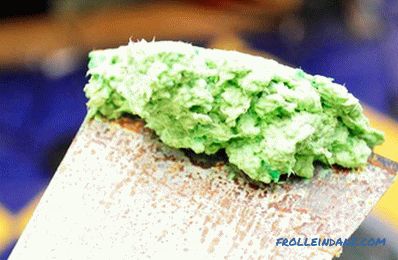 The finished liquid wallpaper can be applied with a metal trowel
The finished liquid wallpaper can be applied with a metal trowel
After analyzing the composition, it becomes clear that self-production is much more economical than buying ready-made wallpaper in the store.
How to make wallpaper from sawdust
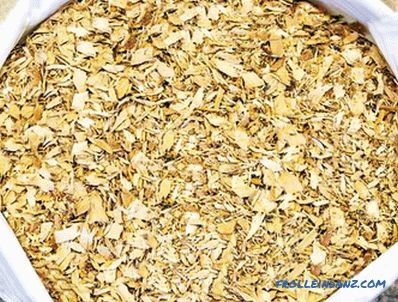 Liquid wallpaper can be made from
Liquid wallpaper can be made from
Sawdust can be used in the manufacture of wallpaper mixture at home. Sawdust itself has a number of positive properties:
- increases the degree of sound insulation;
- additional layer of insulation;
- environmentally friendly material;
- do not allow the appearance of mold.
To make a liquid wallpaper of sawdust, you need:
- 1 kg of sawdust;
- 500 g of gypsum;
- 500 ml PVA glue;
- 5 l of water;
- pigment.
The manufacturing process is similar to that described when using paper. You need to fill the sawdust with warm water and give them time to swell - on average about 4 hours. After added glue, pigments and other additives as desired. The resulting composition must be thoroughly mixed and left for 12 hours. Finally, add gypsum and mix thoroughly with a construction mixer until smooth.
Once the gypsum is added to the mixture, it should be immediately applied to the surface.
Additives
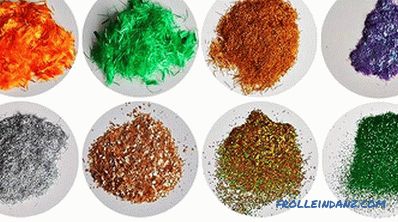 Additives for homemade wallpapers, they can be of different colors and structure
Additives for homemade wallpapers, they can be of different colors and structure
Fiber should be at the heart of any liquid wallpaper. It can be plain cotton, cellulose or cotton. You can also use flax, wool, sintepon, synthetics, silk and the like. The main task is to chop the filler. You can experiment with different fillers, making a small volume with different components. The result that suits you best can be used.
Among other things, binding additives are necessary. In most cases, home craftsmen use PVA glue. If not, then you can replace the usual wallpaper glue or acrylic putty. In the latter case, the hotwork will acquire a sufficiently high strength and will be resistant to all sorts of influences, including mechanical.
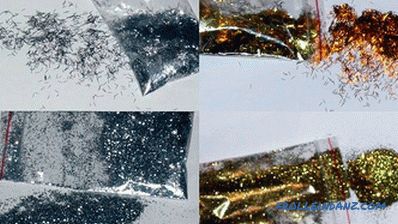 Sequins
Sequins
are excellent as decorative filler. To give a special look, they are also added to the mixture. decorative components. You can use:
- quartz aggregate;
- marble aggregate;
- mica aggregate;
- glitter.
All these materials do not cause mold. Moreover, they can be bought at a hardware store for a small amount. Well, the last important component is dye.
Video
Applying Liquid Wallpaper: Step-by-Step Technology
It is important to familiarize yourself with the technology of applying liquid wallpaper . First of all, pay attention to the preparatory work.
Wall decoration
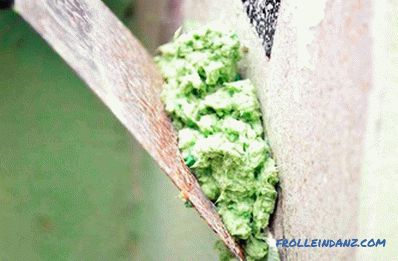 The process of applying liquid wallpaper on the wall
The process of applying liquid wallpaper on the wall
Often in old Soviet houses can be found that the wallpaper is pasted in several layers, even modern vinyl or paper can be glued on top of each other. Although experts do not recommend this, it is possible, however, only under one condition - when the base of the walls is strong enough.
As for liquid wallpaper, this is unacceptable. They must be applied directly to the surface, completely cleaned from the old coating. For this reason, the preparation of the treated areas should be given special attention. This is where work should begin.
Preparation for application
The wall should be free from all kinds of dirt, paint residues, putty, metal or plastic elements, and the like. Ideally, the entire surface is plastered and primed. In this case, they will not absorb much moisture.
If we talk about the preparation of liquid wallpaper, then you should not do them in large quantities. Why? With large volumes it is extremely difficult to derive exact proportions. It is also difficult to achieve a uniform consistency. Experts recommend kneading small portions, to the extent that you can develop in a short time.
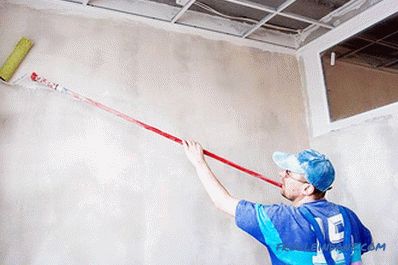 Preparing walls before applying liquid wallpaper
Preparing walls before applying liquid wallpaper
Average 4 m 2 It takes about one kilogram of liquid wallpaper. Given this, you can determine what to do the volume of the mixture.
For all this, it is recommended to mix a small residue with a new one. This is necessary because it is quite difficult to bring out the perfect shade. Mixing the old mix with the new, you level this difference. Although if you adhere to exact proportions, you will not have such a problem.
Video
Application instructions
It is most convenient to apply liquid wallpaper with a transparent plastic float. Working with it, you will immediately understand how to distribute the mixture on the surface of the walls. The very same finishing process is similar to filling. The main goal is uniformity. The optimum layer is the thickness of 1-2 mm.
During the work, it is unacceptable to apply the grater with the whole surface to the wall. It is important to keep it at a slight angle up to 15 °.
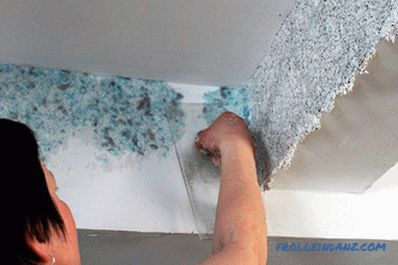 Applying liquid wallpaper to walls
Applying liquid wallpaper to walls
Material can be dialed by hand and gently applied to the surface graters. Then move the wallpaper on the plane to be processed. You can also apply the mixture directly to the wall, and then level it. Everyone chooses the most convenient option.
Each subsequent portion should not be superimposed on the already applied. Depart from this place for a few centimeters and tighten the mixture to the already applied. It is recommended to apply the coating on one wall in one run. In this case, the wallpaper will not have time to dry out when docked with the next batch.
If you work with an internal angle, then the trowel must be applied wallpaper from the corner and level evenly over the surface. If with an external angle, then vice versa, to the corner. Near the floor, the movements should be from bottom to top, from the ceiling from top to bottom. If there are sockets, switches and the like on your wall, then you should apply liquid wallpaper around them first. Otherwise, you can spoil the applied layer. In this case, a transparent trowel is simply indispensable. You can immediately see where to press or better stretch the mixture. At such work the small trowel will be convenient.
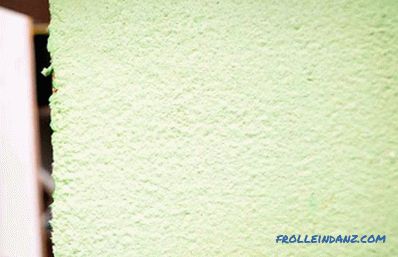 The finished result is on the wall
The finished result is on the wall
When the wall is completely finished, there may be slight roughness on the surface of the wallpaper. To eliminate them, you should take a trowel and moisten it in water, then smooth the entire area. To see these flaws, you can direct the light from the side. This will help to notice and promptly eliminate all existing roughness. When the finish is completely dry, you can install sockets and switches.
Video
Applying liquid wallpaper to the ceiling
Finishing principle the ceiling is the same as the walls. First of all, the surface is thoroughly cleaned from the old coating. If there are cracks, then they are recommended to be eliminated. To do this, you must use a special mesh and putty. If the ceiling is completely cleaned it should be primed. This will ensure high-quality adhesion of the material to the ceiling.
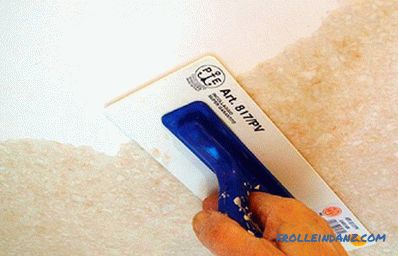 Applying liquid wallpaper to the ceiling, the process is not easy
Applying liquid wallpaper to the ceiling, the process is not easy
There is an option to apply liquid wallpaper using spray gun. After that, the texture can be given a roller. As for the work with a spatula, it is a painstaking process that requires special exposure.
It is important that the mixture has a perfect consistency. If it is very thick, it will lag behind the ceiling and fall off. If it is too liquid, it will drain. Therefore, before applying, test the prepared composition for quality on a small portion of the ceiling. If necessary, you can add water or dry ingredients.
Video
Drawing with liquid wallpaper
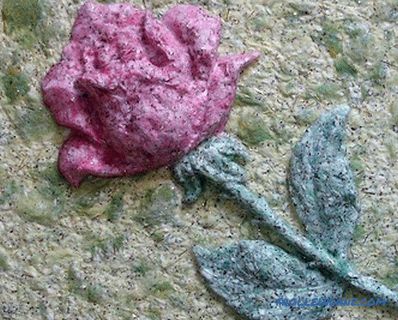 Drawing with liquid wallpaper on the wall, looks very impressive
Drawing with liquid wallpaper on the wall, looks very impressive
The proposed technology allows you to create beautiful drawings on walls and ceilings. You can see the original ideas in the "Photo in the Interior" section at the end of this article. Immediately it should be noted that the application of the pattern is quite a painstaking and lengthy process. If you have no experience, then it may take several days. The situation can be complicated by the fact that different colors and shades can be used.
So, first of all, a future drawing should be applied to a well-prepared wall / ceiling. This can be done in ordinary pencil. Then on the drawn contours apply liquid wallpaper with a layer of 2-3 mm. In this case, it will be convenient to use a narrow transparent trowel with a rounded end.
If you plan to use several colors, then each color should dry well. After that, you can start applying the next shade. In this case, the layers will not mix with each other.
Video
Prices for ready-made mixtures
The prices for different types of liquid wallpaper are shown below. Prices in each region of the country may vary slightly, so consider them as indicative. Some of the products in your area may be missing.
| Name | Price per package | Consumption 1 packaging | Comments |
| Optima | 545 p. | 4-4.5 m 2 | It has a fine-grained structure. Considered a budget option. |
| Standard | 600 p. | 4 m 2 | After application, an almost smooth surface is formed. |
| Relief | 620 p. | 3 m 2 | This type of liquid wallpaper is distinguished by soft pastel tones, as well as pronounced relief. |
| Art Design1 | 860 p. | 3 m 2 | The result is a stylish wall decoration with a bright design texture. |
| Art Design2 | 970 p. | 3 m 2 | Today it is considered one of the modern hits. You can create a beautiful design. |
| Prestige | 730 p. | 3.5 m 2 | In the mixture there are patches of gold and black quartz additives. |
| Provence | 760 p. | 3.5 m 2 | They have delicate pastel colors. |
| Victoria | 890 p. | 3.5 m 2 | Various colors are presented in this series. As for the texture, it has a pronounced relief. |
| RECOAT-1 | 770 p. | 7 m 2 | This type of wallpaper is eco-friendly. The base used is birch wood. |
| Rekoat-2 | 1140 p. | 7 m 2 | It is also environmentally friendly. At the heart of - deciduous and coniferous trees. |
| Rekoat-3 | 1440 p. | 7 m 2 | At the base of this wallpaper are deciduous and coniferous trees. |
| Ecodecor | 1225 p. | 3 m 2 | Aesthetics and environmental friendliness. The material consists of 100% silk. |
| WEST | 1535 p. | 3.5 m 2 | The composition is represented by various components. |
| IST | 1936 p. | 3.5 m 2 | If you want to create a bright interior, then IST are ideal for this solution. |
Photo of liquid wallpaper in the interior
 Seamless application of liquid wallpaper
Seamless application of liquid wallpaper
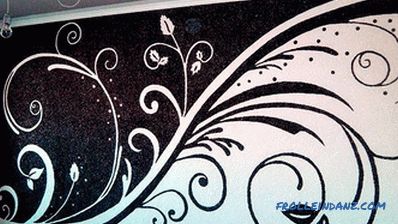 Black and white liquid wallpapers
Black and white liquid wallpapers
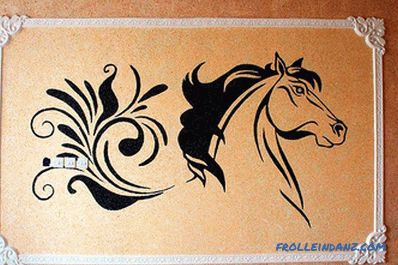 Picture of liquid wallpaper in the frame
Picture of liquid wallpaper in the frame
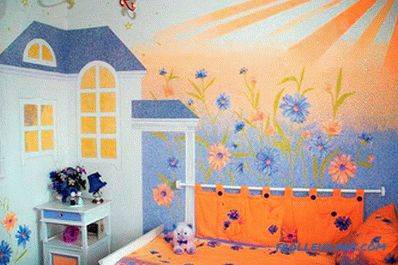 Children's room
Children's room
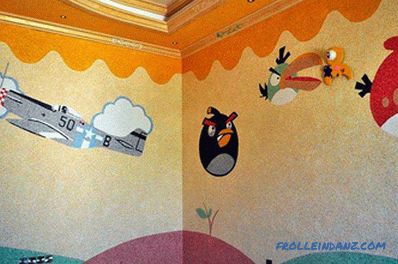 Pictures from liquid wallpaper in the nursery
Pictures from liquid wallpaper in the nursery
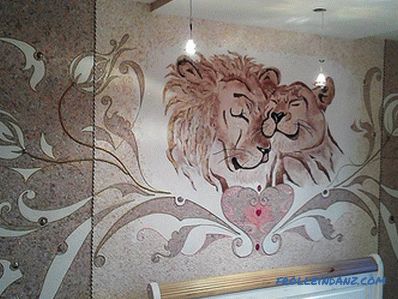 A beautiful picture in the bedroom
A beautiful picture in the bedroom
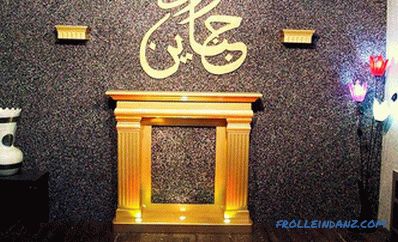 Wall decoration with a decorative fireplace
Wall decoration with a decorative fireplace
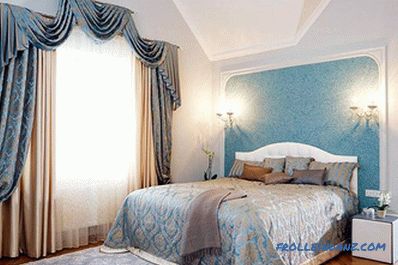 Beautiful bedroom interior using liquid wallpaper
Beautiful bedroom interior using liquid wallpaper
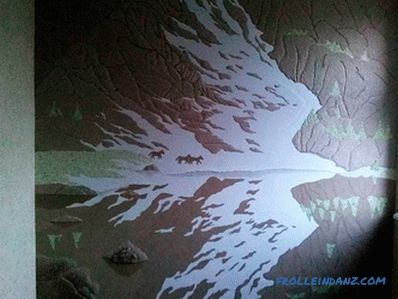 Drawing liquid wallpaper with texture
Drawing liquid wallpaper with texture
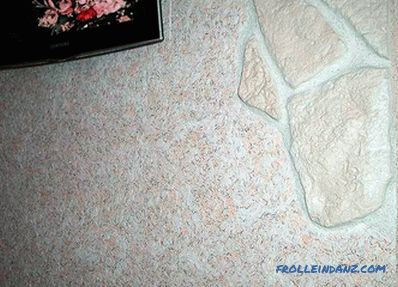 Original wall decoration
Original wall decoration
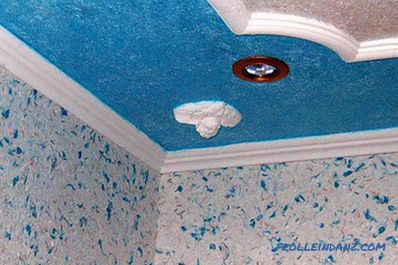 Wall and ceiling decoration with liquid wallpaper
Wall and ceiling decoration with liquid wallpaper
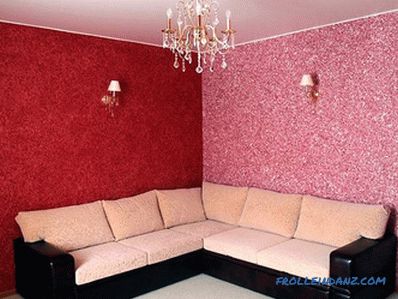 In the living room
In the living room
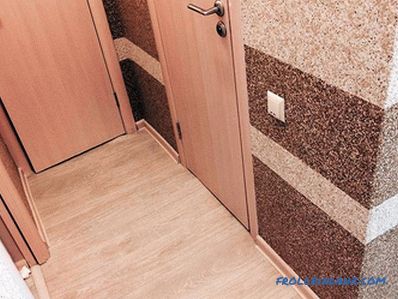 Liquid wallpaper panels
Liquid wallpaper panels
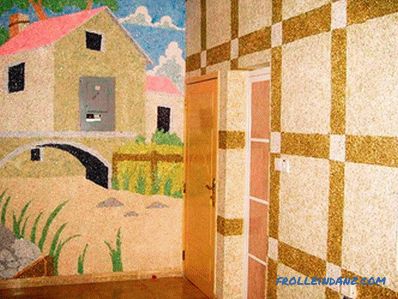 Labor-intensive, but beautiful wall decoration
Labor-intensive, but beautiful wall decoration
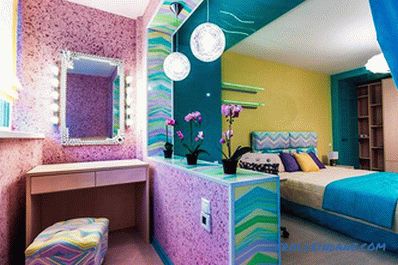 Bright colors of liquid wallpaper
Bright colors of liquid wallpaper
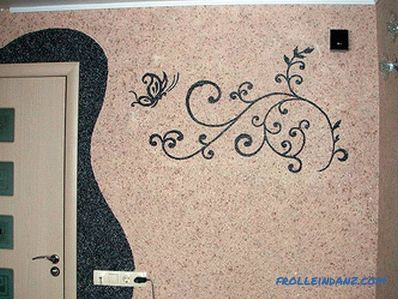 Subtle pattern of liquid wallpaper
Subtle pattern of liquid wallpaper
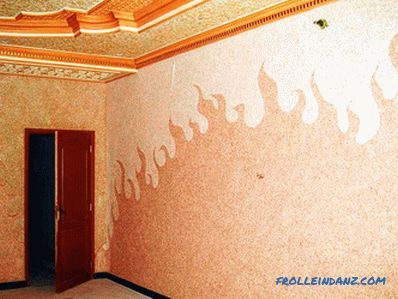 Liquid wallpaper in different colors
Liquid wallpaper in different colors
